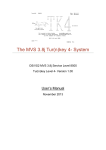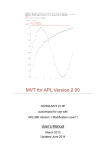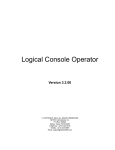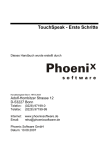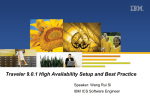Download Bit Bucket x`31`
Transcript
Bit Bucket x’31 ’ Tom Conley, [email protected] Ed Jaffe, [email protected] Sam Knutson, [email protected] Skip Robinson, [email protected] SHARE 124 Session 16458 Seattle, WA 6 March 2015 Secure Socket to Me (Tom Conley) SSL for TN3270 • Don’t assume that your internal network is friendly • You should encrypt traffic on your internal network to prevent passwords from going out in the clear • A robust implementation would use IPSec, AT/TLS to encrypt all traffic on your internal network, but that implementation is time-consuming • You can easily encrypt TN3270 traffic by enabling SSL, ensuring passwords are not in the clear • While not the only way in, TN3270 is a significant percentage of mainframe network traffic, and used by most trusted users on the system © Pinnacle Consulting Group, Inc., 2015. All rights reserved. 3 SSL for TN3270 • Setting up SSL for TN3270 using self-signed certificate and key database takes about 10 minutes • http://www.tombrennansoftware.com/bb/viewtopic.php?f=3 &t=51 shows how to create key database with self-signed certificate, but steps missing due to updates in gskkyman • http://www.tombrennansoftware.com/bb/viewtopic.php?f=3 &t=50 shows how to create a RACF keyring with a selfsigned certificate • If your company has their own Certificate Authority (CA), you can sign certificate with that CA • Self-signed cert gets you encrypted quickly, you can upgrade to a CA cert later 4 SSL for TN3270 5 SSL for TN3270 6 SSL for TN3270 7 SSL for TN3270 © Pinnacle Consulting Group, Inc., 2015. All rights reserved. 8 SSL for TN3270 9 SSL for TN3270 10 SSL for TN3270 11 SSL for TN3270 • Key database and certificate now created • Specify key database in TN3270 parmlib member TelnetParms ; Standard TN3270E Telnet server port Secureport 1234 KEYRING HFS /u/ibmuser/pinnacle.kdb Conntype secure ClientAuth None SSLtimeout 10 SSLv2 • Recycle TN3270 server, OBEYFILE usually fails • Attempt connection with TN3270 SSL client 12 Hardware Management Heaven (Ed Jaffe) A Blast from the Past! • In providing support for a customer, we got a look at their HMC. • It looked very much like the one that first arrived with the original 9672-Rx1 back in 1994! • In discussing this, we learned that the customer was unaware that newer, more functional HMC interfaces have been implemented in recent years. The customer was happy to learn about this. • This episode reminded me of my HMC Bit Bucket presentation from Atlanta (six SHAREs ago) called “View from the Topo” in which I described the HMC’s topology view (subset of the Tree Style interface). • This is a re-visitation of that discussion… HMC Classic Style – A Blast from the Past! 1. Sequentially loop through task lists until you find the right one or randomly choose from “Task Lists” 2. Select the object or group upon which the action is to be performed 3. Drag & drop or select and doubleclick HMC Tree Style – Much Easier to Use and a Necessity for Some Configuration Options HMC Tree Style with a CPC Selected Topology tab opens an easy-to-use view Tasks automatically adapt as needed for selected object and all choices can be expanded with a single click! HMC Topology View Click to expand HMC Topology – Tree Layout HMC Topology – Hierarchical Layout HMC Topology – Circular Layout HMC Topology – Uniform Length Layout HMC Topology – Grid Layout HMC Topology – All Layouts Support Zoom In/Out zoom controls cursor controls right-click menu supports zoom-to and center-here HMC Topology – Zoomed Grid Layout with Overview overview control HMC Topology – Select Object to Activate its Menu HMC Topology – Click >> to Expose Menu for Object zPotpourri (Sam Knutson) Seattle all about the z •Why IBM z Systems? Seattle all about the z • the "z" stands for "zero down time.“ • With a MTTF of over 40 years it’s all about the z FOIL • foil n. Viewgraph, transparency, viewfoil - a thin sheet or leaf of transparent plastic material used for “overhead” projection of illustrations (visual aids). • the term “Foil” was widely used in IBM and SHARE… • the acronym originally stood for “Foil Over Incandescent Light”. • This therefore seems to be IBM’s first attempt at a recursive language. • FOILS5 program gave us a style of presentations and printed handouts that is burned into our collective memory Some Assembly Required • Dr. John Erhman Old books and presentations • http://www01.ibm.com/software/awdtools/hlasm/share.html • To get a deeper understanding of IBM's High Level Assembler and Toolkit Feature, view or download these SHARE presentations (written by John Ehrman of the IBM Silicon Valley Laboratory) • Extending the Life Cycle of Legacy Applications: Specific to Assembler Language • Finding and Fixing Assembler Language Problems: How High Level Assembler Can Help • Assembler Language as a Higher Level Language: Macros and Conditional Assembly Techniques • Continuing to profit from legacy Assembler code • More… Some Assembly Required • Long awaited a NEW Assembler book from Dr. John Erhman released this year • Assembler Language Programming for IBM z System™ Servers Version 1.00 • 1279 pages, How & Why, Exercises • $0 == Priceless! • Marist College web site: • http://idcp.marist.edu/enterprisesystemsed ucation/Assembler%20Language%20Program ming%20for%20IBM%20z%20System%20Ser vers.pdf • Or http://tinyurl.com/qcnzrwc MVS is a Tur(n)key (Sam Knutson) Hercules - What is it? • Hercules is a System/370, ESA/390 and z/Architecture emulator which can IPL and execute most of the instructions defined for these architectures. It can also emulate CKD and FBA DASD, printer, card reader, tape, channel-to-channel adapter, and local non-SNA 3270 devices. • Currently runs under Linux, Windows, Mac OS X • Capable of running nearly all software written for S/370, ESA/390 and z/Architecture • Hercules Home Page http://www.hercules-390.org • Active User Community on Yahoo Groups include hercules-390, H390-MVS, turnkey-mvs, H390-VM, more! • http://groups.yahoo.com/group/hercules-390 MVS 3.8j Tur(n)key 4- System • MVS 3.8j Tur(n)key 4- ("TK4-") is a ready to use OS/VS2 MVS 3.8j system built specifically to run under the Hercules System/370, ESA/390, and z/Architecture Emulator. It is an extension of the original MVS Tur(n)key Version 3 System ("TK3") created by Volker Bandke in 2002. See the User’s Manual for credits and copyrights. • TK4- update created by Juergen Winkelmann • http://wotho.ethz.ch/tk4-/ provides the downloads includes a user guide, optional source code, optional CBT DASD, and the most current copy of TK- along with incremental updates if you have downloaded it previously. • TK4- is a personal preference of the author on how to operate and maintain a vintage MVS system. MVS 3.8j Tur(n)key 4- System Downloaded in about 10 minutes Unzip everything takes about 500M Double click MVS.BAT TN3270 to localhost port 3270 At this point everything works but you may now want to read the user manual • You will find the USERID and Password to logon which is HERC01 CUL8TR • • • • • MVS 3.8j Tur(n)key 4- System • Startup complete TN3270 to port 3270 on localhost MVS 3.8j Tur(n)key 4- System • System is ready to use with many tools that you might also find work and would be useful on z/OS • REVIEW (RFE) & IMON http://www.prycroft6.com.au/software.html • RPF http://members.quicknet.nl/rn.prins/Rpf_En.htm MVS 3.8j Tur(n)key 4- System • HTTP Console for Hercules is below which you access using a Web browser on your PC http://localhost:8038/ MVS 3.8j Tur(n)key 4- System • If you want an MVS console on HTTP Console for Hercules issue attach 010 3270 CONS • Connect a TN3270 to Hercules with LUNAME CONS. I like Vista 3270 from Tom Brennan http://www.tombrennansoftware.com/ • Then issue /v 010,console,auth=all at the HTTP Console Irreconciled Differences (Skip Robinson) Irreconciled Differences • • • • • We use Netview System Automation (SA) We depend heavily on it for Startup and shutdown Task restart Message handling • • • • • Our first z/OS V2.1 was IPLed on a sandbox system Member of a small, fully functional parallel sysplex Like all our sysplexes, 'everything is shared' Had been running R13 since our ESP days Now running different levels--SOP for new rollout • To respond to WTOR • To take some other action Irreconciled Differences • • • • • • Most everything came up fine System Automation did not All kinds of errors and failures Especially with message handling Under R13 everything worked fine Used all the same files except sysres-resident • • • • • • • We opened SR with IBM: Level 2 was mystified R13 Serverpac had come with Netview 6.1 and SA 3.3 V2.1 Serverpac came with Netview 6.2 and SA 3.4 Much doc flowed over the interweb Many suggestions offered and implemented Lots of frustration and delay ensued V2.1 rollout was stuck on the first sandbox system Irreconciled Differences • Eventually someone mentioned Subsystem Name Table • IEFSSN defines z/OS subsystems for IBM, vendor, and user • Includes entries for Netview and SA • We try to avoid duplicating similar PARMLIB members • Causes confusion, prone to error over time • Here we created two members: Shared 00 and release-specific 01 • Concatenated as (00,01) • Layout of IEFSSN00 • • • • • SMS JES2 Two entries for TCP/IP (don't ask me why) BEGINPARALLEL A whole bunch of other entries Irreconciled Differences • IEFSSN01 contained only entries for Netview and SA • Why? Skip's hot button: incompatible product changes • Netview V6 had changed SSN by adding INITRTN(DSI4LSIT) • Netview V5 could not tolerate this parameter • I.e. R13 could not share SSN member with R12 • Skip's Rube Goldberg workaround • Isolate Netview entries in a separate 01 member • Put unique IEFSSN01 on SYSRES for R12 and R13 • Share IEFSSN00 in the common PARMLIB • Result: entries for Netview/SA were at the bottom • This worked fine for R12 and R13 • SYSRES for V2.1 was built the same way • Even though the compatibility issue was long gone Irreconciled Differences • This layout of SSN entries was the culprit • z/OS 2.1 with Netview 6.2 and SA 3.4 was broken • I moved Netview and SA entries to -00 before BEGINPARALLEL • Eliminated -01 altogether • Result works fine for both R13 and V2.1 • After months of stagnation, problem vanished • Conclusion: incompatible parm changes are deadly • Customer is forced to invent his own cockamamie accommodation • This particular customer is not smart enough to survive the challenge My Head on a JES2 Block • • • • Several JES2 control block changes in V2.1 Some fields moved from $DTE/$DCN to $CIWORK This was done in support of ‘batch modernization’ In Exit 6, we used these fields • DCNVMSG ‘ACB FOR SYSTEM MSGS DATA SET’ • DCNVSCHE ‘Scheduling environment for job’ • DCNVCAT ‘Address of CAT for job’ • These and other fields are now in $CIWORK • Pointed directly to by exit parm list word 6 (+20) • • • • • CIWBMSG ‘ACB for system msgs data set’ CIWJSCHE ‘Scheduling environment’ CIWCATA ‘Address of CAT for job’ Control block changes hit exits up front Regardless of JES2 run time options Robo Logo • • • • In vanilla ISPF, primary panel displays a ‘logo’ Really an IBM copyright notice We have never displayed it But in new ISPF, we could not suppress it +----------------------------------------------+ | Licensed Materials - Property of IBM | | 5650-ZOS Copyright IBM Corp. 1980, 2013. | | US Government Users Restricted Rights | | Use, duplication or disclosure restricted | | by GSA ADP Schedule Contract with IBM Corp. | +----------------------------------------------+ Robo Logo We modify primary panel ISR@PRIM a lot Same mods appeared to carry forward with no error No change we could see would explain this behavior After discussion on IBM Main, we commented out two lines • Logo no longer displays • • • • /* .MSG = ISRLO999 /* .RESP = ENTER Set logo information Simulate enter @L5A*/ @L5A*/ SHARE in Orlando Preview! • z/OS 2.2 sessions aplenty! • Bob Rogers will be doing How you do what you do when you're a z13 CPU *and* Sysprog Goody Bag • New to z track • Glenn Anderson will be back and doing an MVS Dispatching update • Tom Wasik (IBM) will be back with JES2 update & more • A flock of User Experiences: Insourcing Experiences, Datacenter move, RD&T, z/OS 2.2, migrating from HTTP server to Apache, Auditors Myths, COBOL 5, Large Memory exploitation • Deep technical content z13, z/OSMF, USS, ISPF, Print Acknowledgements Both Knowing and Unknowing • • • • • Jay Maynard, http://www.conmicro.com/ Volker Bandke, http://www.bsp-gmbh.com Juergen Winkelmann, http://wotho.ethz.ch/tk4John P. Kalinich, [email protected] Mary Ann Matyaz, [email protected] See You in Orlando





















































